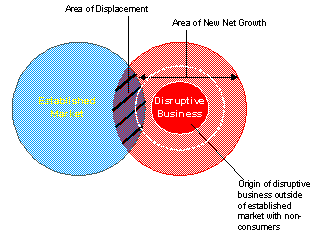r e s o u r c e s
what is disruptive innovation?
Our research and consultancy
shows that disruptive breakthrough products (both tangible products
and intangible services) appear in three major forms:
1. Low-end disruptions.
2. New-market disruptions.
3. Next generation breakthroughs.
Note: these categories
are not mutually exclusive; an innovation can begin in one category
and migrate to another during its exploitation path.
The focus of this introduction
is on the first two types: low-end and new-market disruption:
The notion of ‘low-end
disruption’ was pioneered by Harvard Business School’s
Clayton Christensen. This form of disruptive innovation is based on
commonly recurring observations made in countless industries (see
Figure 1):
* The performance demanded by customers within an existing market
can be mapped onto a normal distribution curve, from low-demanding
to high-demanding customers (see the green curve at the right-hand
side of Figure 1).
* Average customers make up the mainstream market, and over time all
customers either demand or are able to absorb improved performance
(line ‘A’ in Figure 1).
* It is the customers’ ability to absorb and demand more performance
that creates a major drive for product performance improvement (line
‘B’ in Figure 1).
* Competitive pressures in the market place will often force the performance
improvement provided to take a different trajectory to that of performance
improvement demanded or that can be absorbed by the customers. For
instance, this can occur when management teams ‘fall in love’
with their technology and ‘technology myopia’ sets in,
or simply when there is a desire to beat the competition.
* When performance provided exceeds performance demanded (points ‘O’
and ‘D’ in Figure 1), we can say that
the market is in a state of performance-oversupply.
* The feature of performance-oversupply literally creates a vacuum
into which simpler, more convenient customer offerings are drawn.
Thus, new technologies and products that were only performance-competitive
in low-end niches with low-demanding customers may migrate upwards
into the mainstream market (note that line ‘C’
in Figure 1 represents a new low-end product offering that gradually
moves into the ‘mainstream market’ with a disruptive effect).
* The prevalence of performance oversupply in the market can provide
low-end innovators with a vehicle to new customers at the low-end
of the mainstream market. These customers would have previously viewed
such products as substandard, however, when the alternative is a product
that significantly oversupplies their needs, the low-end offering
can establish a foothold.
* This process enables new low-end entrants to significantly grow
revenues, enabling them to improve their product. Eventually they
can offer established mainstream markets new performance attributes
that are now more relevant than those offered by the traditional market
leaders – e.g. low costs or convenience.

Figure
1: The process of low-end disruption
Managers
can also deliver ‘new-market disruptions’,
which have the following features (Figure 2):
*‘Non-consumers’ instead of low-end customers are the
target. By addressing a niche of people who currently do not consume
the traditional product, organisations can create a new niche market.
* New markets can be established by creating a simple, convenient
product that allows a new market niche to do things that they would
not have other wise been able to do.
* The growth of such new markets is often ignored by established companies.
They are considered too small, not-profitable, and the technologies
used are often considered too different and are therefore viewed as
substandard compared to the existing company focus.
* Much like the low-end disruptions described above, the incremental
improvements of the new-market product allows the new niche market
to grow.
* Eventually, customers who face performance-oversupply in established
markets or who value the convenience of the new-market product are
tempted to switch to the new product.
* Quite often by the time traditional market leaders begin to notice
their customer defection to new markets, its too late - market disruption
has set in.
* Once market disruption sets in, the attributes offered by the new
product and the new entrants permanently reshape the traditional market
place.
Note: it is common for new-market innovations to migrate to the
low-end disruptive approach.

Figure
2: The process of new-market disruption
Return
to the Disruptive Breakthrough page
|
The
Insight Centre
Delivering breakthrough innovation and change